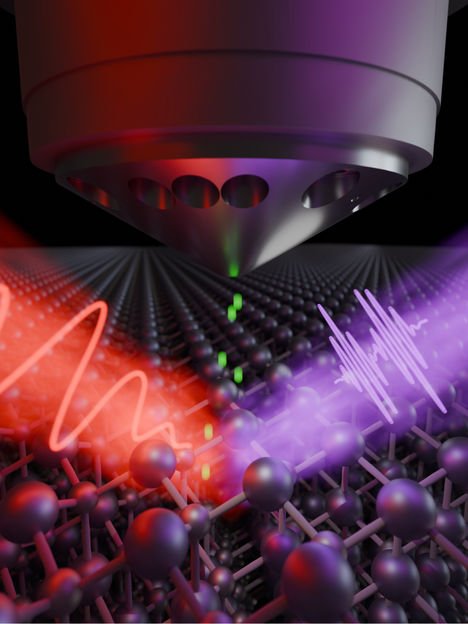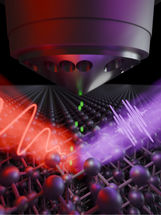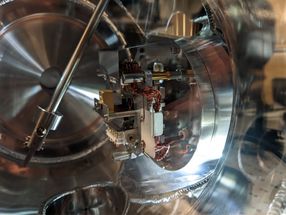Progress in the investigation of fast electron movements with short light pulses
Advertisement
A German-Swedish team has now succeeded in studying the rapid movements of electrons simultaneously with high spatial accuracy and a temporal resolution in the attosecond range. The researchers combined a special variant of electron microscopy, known as photoemission electron microscopy (PEEM), with the possibilities of attosecond physics. They used unimaginably short flashes of light to precisely control the movement of electrons and record their behavior. In future, the method could be used to better understand the behavior of electrons in nanomaterials or in new types of solar cells.

Schematic representation of the experimental set-up: Attosecond pulses (violet) release electrons (green) from a crystal surface. The photoemission electron microscope (cone-shaped instrument above) examines the rapid movements of the electrons.
Jan Vogelsang

A look inside the vacuum chamber of the photoemission electron microscope in Lund: the research team used a similar device to examine electrons that had been extracted from a sample using laser pulses.
Jan Vogelsang


When an electron moves in a molecule or a semiconductor, this happens in unimaginably short periods of time. A Swedish-German team led by physicist Dr. Jan Vogelsang from the University of Oldenburg has now made significant progress towards a better understanding of such processes: The researchers tracked the movement of electrons released from crystals of the compound zinc oxide by a laser pulse, simultaneously with a spatial resolution in the nanometer range and previously unattained temporal resolution. The team thus demonstrates the applicability of a method that could be used, for example, to better understand the behavior of electrons in nanomaterials or new types of solar cells. The study, which was published in the journal Advanced Physics Research, involved researchers from Lund University, including this year's Nobel Prize winner in Physics, Prof. Dr. Anne L'Huillier.
In the experiments, the team combined a special variant of electron microscopy, known as photoemission electron microscopy (PEEM), with the possibilities of attosecond physics. Researchers use unimaginably short flashes of light to precisely control the movement of electrons and record their subsequent behavior. "You can imagine the process as being similar to photography, where a fast movement is virtually frozen by a flash," explains Vogelsang. An attosecond is the billionth part of a billionth of a second.
As the team reports, similar experiments had previously failed to achieve the temporal accuracy required to track the movement of electrons. The small elementary particles whizz around much faster than the larger and heavier atomic nuclei. In the current study, however, it was possible to combine the two technologically demanding methods of photoemission electron microscopy and attosecond microscopy without compromising the spatial or temporal resolution. "We have now finally reached the point where we can practically use attosecond pulses to study the interaction of light and matter at the atomic level and in nanostructures in detail," says Vogelsang.
One of the factors that made this progress possible was the use of a light source that generates a particularly high number of attosecond flashes per second - in this case 200,000 light pulses per second. Each flash released exactly one electron from the surface of the crystal, allowing the researchers to study its behavior undisturbed. "The more pulses per second you achieve, the easier it is to extract a small measurement signal from a data set," explains the physicist.
The technology required for this is available in Anne L'Huillier's laboratory at Lund University (Sweden), where the investigations for the current study also took place. Vogelsang, who was a postdoctoral researcher at Lund from 2017 to 2020, is currently also developing the method at the University of Oldenburg. In the future, both teams want to continue the investigations and explore the behavior of electrons in different materials and nanostructures.
Note: This article has been translated using a computer system without human intervention. LUMITOS offers these automatic translations to present a wider range of current news. Since this article has been translated with automatic translation, it is possible that it contains errors in vocabulary, syntax or grammar. The original article in German can be found here.





























































